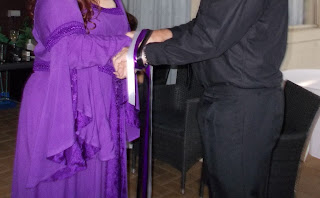1…In an indoor ceremony arrange a rehearsal a week before the wedding if convenient for everyone needing to be present
2…In an outdoor ceremony, rehearse at the time of day and week as the wedding ceremony couple of weeks before the wedding day
Who attends the rehearsal?
1…The Celebrant attends to help with the setting of the bridal party
2…Bridal attendants who will be part of the wedding party
3…Readers who will be included in the wedding ceremony
4…Parents who might be involved in the wedding ceremony
5…Musicians who will time the various wedding ceremony events
6…Those people who have been given a role as helpers in various capacities
7…A number of stand-ins for absent participants who will later be told anything they need to know
How do I decide on my ceremonial site?
1…Position your wedding party in different areas to find the most attractive focal point for your ceremony and for your wedding photographs
2…Decide on the best place for the table and chairs for the signing of the documents so it can be seen by all the guests and allow for easy photography
3…Look over the area and see if aisles are desirable for the processional and how to define them – aisle-runner, plants, ribbons, flower petals, protected candles, attractive pebbles or sea shells
4…If you intend to use an aisle-runner, appoint specific people and advise them when the aisle runner should be put in place, such as when the bride arrives at the ceremony venue just before she is ready to make her entrance
5…Instruct the same people when the runner is to be remove – preferably once the guests have left the ceremonial site
6…If rose petal path is to be created, appoint specific people how and when you want the area covered
7…Ask that on the wedding day the petals are placed some thirty minutes before the wedding ceremony and have them covered with a sheet so that the wind doesn’t disturb the petals beforehand if the wedding is outdoors
8…On the day arrange that the sheets be taken off as the guests begin to arrive
9…Have the same people who created the petal area, sweep up the petals at the end of the ceremony
How do I arrange the seating at an outdoor site?
1…Decide whether you will provide seats for all or only some of your guests
2…Decide on how to arrange the chairs so that all the guests can see the wedding party
3…Rather than placing them in straight lines, try curving the lines of the chairs towards where the bridal party will be standing
4…Try placing the chairs in a semi-circle around the bridal party
5…To generate feeling-good atmosphere, make the distance between guests and the wedding party shorter rather than longer
6…Initially set up chairs for two-thirds of the expected guests and the rest of the chairs stacked close by
7…Continue to add rows of chairs as guests begin to arrive so that there’s no empty chairs no matter how few or how many guests arrive
8…If there’s an aisle between the chairs, encourage guests to fill both sides irrespective of which side of the family they belong to
How do I arrange the seating at an indoor site?
1…Make a floor plan of how the venue will actually look on the day of the ceremony
2…Mark out areas which will be taken up with flower pedestals, wedding arch, potted plants, speaker’s stand, music stand and other large decorations
3…Place a few rows of chairs to see how close the guests can be seated without encroaching upon the wedding party
4…Using chairs, create a suitable aisle for the bridal party
5…Decide where to place chairs for young attendants who will take part in the bridal march but will not be standing with the adults
6…Place a special and a favorite toy on the chair to identify the seating for the child
7…Leave extra chairs for the carers of the children
8…Make your entrance and your exit being aware of how much space you’ll have once the venue is completely set up for your wedding day
What props do I bring to the rehearsal?
1…Half a dozen programs to follow the ceremony format
2…Substitutes for bouquets so that the attendants can decide how to carry them and how to hold them
3…Imitation wedding dress train and veil to make sure that the bride and her attendants know how to handle them on the day
4…Shoes being worn at the wedding day to test their comfort and practicality
5…Ring pillow to help the ring bearer become familiar with his task
6…Flower girl baskets filled with bits of paper for practicing tossing petals
7…Recorded music being used on the wedding day
8…Candles, chalices, roses, handfasting ribbons and other props that require practicing an action
9…Video recorder to record the whole process from processional to recessional to be viewed later to see if anything needs to be changed
10..Rehearse the children in the clothes and shoes they’ll be wearing on the day to discover if there’s anything too tight, too loose, too big, too scratchy or just generally uncomfortable for the child
Which part of the ceremony do I rehearse first?
1…Place the whole bridal party at the ceremonial site as if the ceremony is to begin – this includes the bride and groom, the celebrant, and all the bridal attendants
2…From that position, acting as if the ceremony has just finished, begin the recessional
3…Having practiced the recession several times, practice the wedding march
4…When you’re happy with both the recessional and the processional, practice the actions of the wedding ceremony itself – father handing over the bride, couple facing each other to begin their vows, readers walking towards the speaker’s stand, Best Man handing over the rings
From the book ‘1,000+ Answers to Your Wedding Questions’.
Check out the different ways you can Celebrate your Wedding and how to begin planning your Wedding Day.
Connect with Me
Connect with Me





